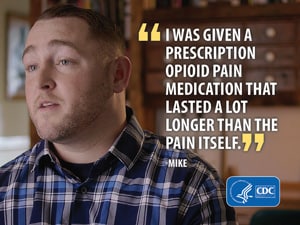Safely and Effectively Managing Pain Without Opioids
Pain whether chronic or acute, can be devastating, and unfortunately it is a reality for many people. Effective pain management can reduce pain and help improve function so people can enjoy doing what matters to them most.
Making Decisions About How to Manage Your Pain
To find effective treatment options, talk to your doctor about managing your pain safely. A conversation with your doctor can help you understand nonopioid pain management options. Discuss
- your health history,
- how your activities have been impacted by pain, and
- what you hope to gain from managing your pain.
Having detailed discussions with your doctor about your pain management and function goals can help your doctor identify the best treatment with the lowest level of risk.
Know about the different types of pain
Acute pain: usually starts suddenly and has a known cause, like an injury or surgery. It normally gets better as your body heals.
Chronic pain: lasts 3 months or more and can be caused by a disease or condition, injury, medical treatment, inflammation, or even an unknown reason.

- Work with your doctor to make and follow a plan
- Set realistic goals to return to an activity that pain prevents you from doing
- Choose low risk pain relief options
Know Your Options for Pain Management Without Opioids
There are many options for pain management that do not include prescription opioids. Some options may work better and have fewer risks and side effects than opioids.
- Acetaminophen (Tylenol®) or ibuprofen (Advil®)
- Topical Ointments (for example lidocaine)
- Exercise therapy, including physical therapy
- Interventional therapies (injections)
- Exercise and weight loss
- Medications for depression or for seizures– some anti-depressants and anti-seizure medications have been shown to relieve chronic pain
- Cognitive behavioral therapy – a psychological, goal-directed approach in which patients learn how to alter physical, behavioral, and emotional responses to pain and stress
- Other therapies such as acupuncture and massage
Develop a Pain Management Plan with Your Doctor

Now that you know some of the options that may help you meet your pain management goals, work with your doctor to make and follow a pain management plan. Here are some things to remember when making a pain management plan:
- Be open to managing pain without opioids
- Be informed and know your options
- Talk to your doctor about which options may work for you; work with a specialist if needed
- Follow up regularly with your doctor about your pain and whether your plan is working or not
- Understand that it can take time to reduce your pain
- Patients’ Frequently Asked Questions
- Conversation Starters if You Have Chronic Pain (cdc.gov)
- Conversation Starters If You Are Prescribed Opioids (cdc.gov)
- Nonopioid Treatments for Chronic Pain
- Know the Risks (Patient Information)
- Opioid Information for Patients
- Opioid Prescribing Vital Signs
- Rx Awareness Campaign


